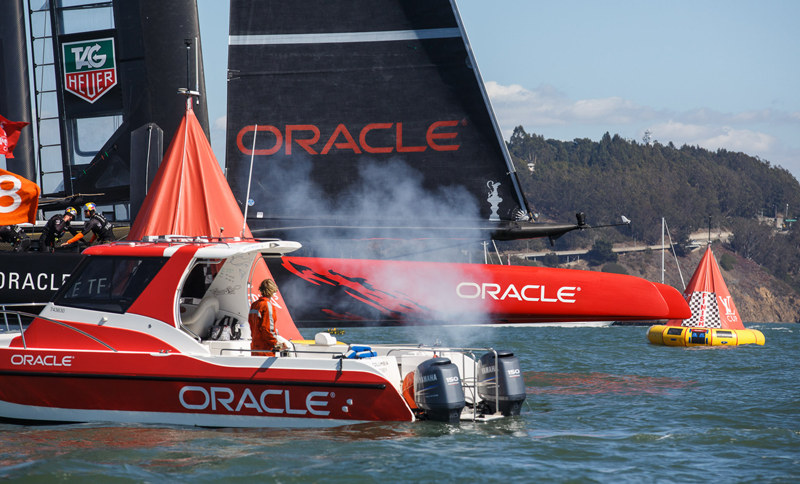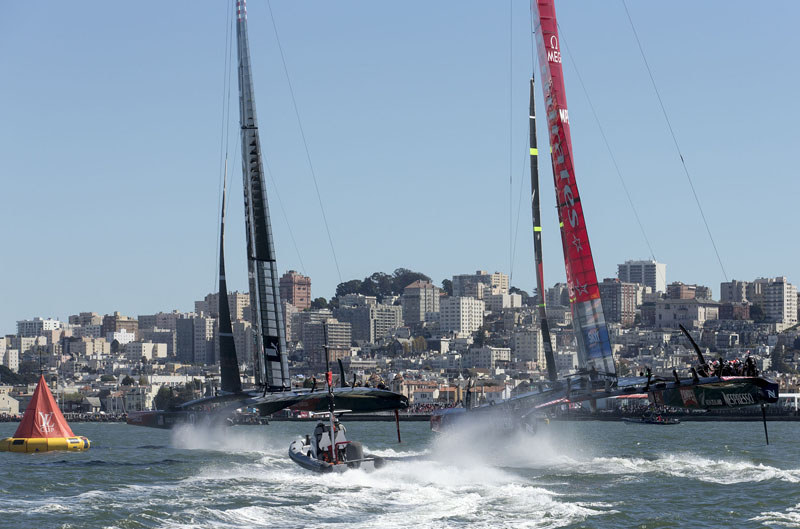
Kiwis Foiled Again

The 34th America’s Cup, already by far the best in the 162-year history of the event, just keeps getting more thrilling.
Sunday’s races were packed with nail-biting drama, as for the fourth day in a row, Dean Barker and Emirates Team New Zealand needed to win just one more race to eliminate Oracle Team USA and take the Cup to Auckland. On the other hand, Jimmy Spithill and the Oracle team have been looking better on the water than the Kiwis, having won all of the last four races.
Having had Cup races postponed in recent days because of too much wind, lack of wind, and wind being out of the wrong direction, Regatta Director Iain Murray announced Sunday morning that there was a whale on the course and there might be a ‘whale postponement’. This was not good news, as Sunday was supposed to have been the last day of the America’s Cup, and many Kiwis had reservations to fly home immediately after Sunday’s races. Fortunately, the whale, apparently not wanting to get sliced by a catamaran daggerboard at 40 knots, cleared the race area.
The starts of both races were terrific, with Oracle gaining a very slight advantage at the first mark both times, then showing superior downwind speed which allowed them to pull away. Tactically, they were both great races, with the first one being particularly difficult as there were light spots on both the windward and second downwind leg. Having fallen far behind at the beginning of the second downwind leg, the Kiwis made up close to 150 yards in the first race and nearly 700 yards in the second race. Oracle prevailed by 23 seconds and 37 seconds respectively, which doesn’t begin to tell the story of how exciting these race were. You owe it to yourself to watch them on YouTube.

Sensing what might become one of the greatest comebacks in the history of sport, many people started jumping on the Oracle bandwagon. And judging from a comment in the San Francisco Chronicle, many non-sailors have suddenly found themselves hooked by the drama. It was even front page news in today’s New York Times.
The scoreboard now reads the Kiwis leading 8 to 5, which means Oracle has to win both races today and tomorrow to retain the Cup. But it’s deceptive, as on the water the Kiwis have won 8 races to Oracle’s 7. The difference between the scoreboard and what’s happened on the water is the two-race penalty that Oracle was hit with as a result of the AC45 cheating scandal. Like the Watergate break-in that seemed so insignficiant at the time, the stupid AC45 boat modification penalty looms gigantic, for without it, the score would now be 8 to 7 and the pressure would really be on the Kiwis.
The reality now, though, is that Oracle’s need to win both races today is a tall order. It also raises two ugly possibilities. First, that the Kiwis could win the Cup despite having won fewer races, leaving an asterisk in bold type on the record book. Second, if Oracle loses the Cup because of the penalty, Ellison, no stranger to legal battles, will sue. The rumor mill is in overdrive that the lawyers are already building a case.
The context of today’s racing couldn’t be more dramatic. Reasons to favor Oracle include the fact that they are showing excellent boatspeed, the crew work has been very smooth, and tactician Ben Ainslie has been a tactical ‘oracle’ when it comes to deciding which way to go. Reasons to favor the Kiwis is that they still need to win only one race out of four, they get the favored start in both races today, they’re in the midst of a three-race bad luck streak in which they were leading races only to have them called off, and it would only take one favorable windshift, getting to the breeze first, or an Oracle screwup for the luck to even out and give the Kiwis a win — and the Cup.
But the pressure is on the Kiwis, as they had the big lead. And no Kiwi has to be feeling more pressure more than helmsman Dean Barker. A hero early in the series, it’s been pointed out that he’s now lost more America’s Cup races than anyone in history.

How can the Oracle cat now seem to be faster in most situations than the Kiwis’? The deal is that there are so many variables in these boats, each of which can make a big difference by itself or in conjunction with other changes. For example, in yesterday’s races Oracle went with L-shaped boards, which are faster but harder on the helmsman, while the Kiwis went with the more forgiving but sightly slower J-shaped boards. Longtime Bay racer Craig Healy told us that Oracle may have changed the length of the chords in the boards, and that could make a difference. Early in the series, Jeff Thorpe of Quantum Sails was all but screaming that Oracle needed more rake in their mast, which generally helps with upwind performance. It’s hard to tell, but it looks as though they have done that.
Not only do the teams have to get the balance of all the variables in their boats just right, they have to get them just right for the sailing conditions. Some things, such as the size of the jib, can be done right before the start of the race. Others, such as the critical daggerboard choice, must be made before they leave the dock.
Once the racing starts, there are even more decisions, such as when to foil when sailing upwind. Oracle did it at speeds to the mid-30s yesterday to good effect, but as Oracle tactician Ainslie told Latitude, it’s a very tricky decision when to foil and when not to, because it can be very costly in even a slightly unfavorable windshift.
There has been a steep learning curve in finding the perfect balance between all the many factors in the boats. When asked how steep at yesterday’s press conference, the Kiwis’ Glenn Ashby pointed his hand straight up.
The correct tactical decisions, of course, can negate all differences in boatspeed, and yesterday Oracle’s Ainslie was on fire, making one right — although sometimes risky — tactical decision after the other. It was fabulously exciting to watch. Kiwi tactician Ray Davies, a hero in the early races, missed the after-race press conference for the first time. Everyone should remember that it’s a little more difficult to make the correct tactical decisions in the heat of battle than when sitting on a bar stool with a great overall picture of the situation provided by Stan Honey and his team’s graphics.

We’re not going to say never, but it’s unlikely that you’re going to see sailing drama like today’s — maybe tomorrow’s — in a long, long, long time. So don’t miss it!
Our prediction? In wind under 15 knots and/or with patches of light winds, the Kiwis end it. In anything over 16 knots, Oracle will live to sail again tomorrow.
Looking for Land Crew
"I’m going to be driving down to La Paz next month with Bernard and Becky Robinson who live there on their San Diego-based powerboat Worth Waiting 4," writes Ginger Clark. "I need to find two or three people who will drive back with me. I’ve timed my arrival for early November to catch folks who want to get home after the Ha-Ha but don’t want to bash back. I’ll be ready to head back north shortly after the Ha-Ha fleet arrives in Cabo, and it would be particularly great if my ‘land crew’ could make it up to La Paz to meet me. Then they could regale me with lies and tales about this year’s event all the way back to the States. If anyone’s interested, they can email me directly."
©2013 Latitude 38 Media, LLC
We also suggested to Ginger that she check with Club Cruceros and the marinas in La Paz, so if you think you might like to hitch a ride north with a delightful lady, get in touch with her right away!
Variation on a Theme
Since innovative multihulls are in the spotlight this summer, we thought we’d introduce you to another variation on the theme. While traveling in Russia a few months ago, reader Larry Radcliffe of El Cerrito came across this odd-looking trimaran as it was sailing into the docks at Petrozavodsk (on a northern lake, east of Finland).

Larry was pretty sure the boxy craft wasn’t a hydrofoiler, but it seemed to be purpose-built for a specific function. What function? Sadly, he never found out due his inability to speak the local tongue.
What’s your analysis? Is she merely a pleasure craft? A shallow-water fishing boat? A stealth spy vessel? A prototype for the next America’s Cup? Or something else. Write us here with your thoughts. The best answer — whether factual or whimsical — will win an official Latitude 38 cap.
